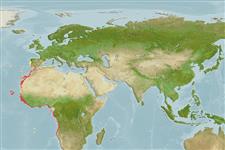Actinopterygii (ray-finned fishes) >
Perciformes (Perch-likes) >
Haemulidae (Grunts) > Haemulinae
Etymology: Pomadasys: Greek, poma, -atos = cover, operculum + Greek, dasys = with hair (Ref. 45335).
Environment / Climate / Range
Ecology
Marine; brackish; demersal; depth range 10 - 100 m (Ref. 6946). Subtropical, preferred 27°C (Ref. 107945); 47°N - 14°S, 27°W - 14°E
Eastern Atlantic: Strait of Gibraltar to Angola (Ref. 6946, 57395), including islands. Reported once from France (Ref. 4517), and from Italy (Ref. 95687).
Size / Weight / Age
Maturity: Lm ? range ? - ? cm
Max length : 50.0 cm TL male/unsexed; (Ref. 57395); common length : 25.0 cm TL male/unsexed; (Ref. 6946); max. reported age: 7 years (Ref. 52657)
Short description
Morphology | Morphometrics
Dorsal
spines
(total): 12;
Dorsal
soft rays
(total): 15-16;
Anal
spines: 3;
Anal
soft rays: 11 - 13;
Vertebrae: 27. Diagnosis: body oblong; snout short, about equal to eye diameter; mouth small, maxilla not reaching anterior edge of eye; 2 anterior pores on chin, followed by a median pit; third anal fin spine equal or longer than second; 11-13 anal soft rays; caudal fin forked; scales slightly ctenoid; 7-8 scale rows between lateral line and middle of spinous dorsal-fin base (Ref. 57395).
Coloration: back dark brown, silvery white on belly; sometimes large dark spots on back and flanks, but never small spots or bands; a black spot at upper angle of opercle (Ref. 57395).
Found over hard bottom (Ref. 2683, 57395) and sand (Ref. 57395). Enters estuaries and lagoons at sexual maturation (Ref. 57395). Feeds on bottom and near-bottom invertebrates (Ref. 5535).
Life cycle and mating behavior
Maturity | Reproduction | Spawning | Eggs | Fecundity | Larvae
Oviparous, distinct pairing during breeding (Ref. 205).
Roux, C., 1990. Haemulidae. p. 783-788. In J.C. Quero, J.C. Hureau, C. Karrer, A. Post and L. Saldanha (eds.) Check-list of the fishes of the eastern tropical Atlantic (CLOFETA). JNICT, Lisbon; SEI, Paris; and UNESCO, Paris. Vol. 2. (Ref. 6946)
IUCN Red List Status (Ref. 115185)
CITES (Ref. 94142)
Not Evaluated
Threat to humans
Harmless
Human uses
Fisheries: minor commercial
More information
ReferencesAquacultureAquaculture profileStrainsGeneticsAllele frequenciesHeritabilityDiseasesProcessingMass conversion
Tools
Special reports
Download XML
Internet sources
